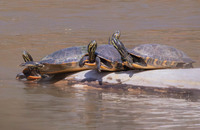Taxonomy
Class: ReptiliaOrder: TestudinesFamily: EmydidaeSubfamily: Deirochelyinae
Taxonomic Comments: One of eight species in this genus that occurs in North America north of Mexico (SSAR, 2017). Two have been recorded in North Carolina. In a molecular analysis of this genus, however, Spinks et al. (2013) found little support for the separation of many of the species in this genus. Our two species, at least, appear to be distinct from one another.Species Comments: There is uncertainty regarding subspecific taxonomy of P. concinna . Traditionally, two subspecies are known from North Carolina: P. c. concinna (Eastern River Cooter) and P. c. floridana (Coastal Plain Cooter). We include accounts for both in this website, but the two forms often intergrade in North Carolina and there are questions as to how distinct they truly are (see discussion in Palmer and Braswell, 1995, Beane et al., 2010, and SSAR, 2017). Some authors (e.g., Powell et al., 2016) treat these forms as separate species (but see Spinks et al., 2013). SSAR (2025) considered P. c. floridana a full species ("P. floridana ") citing TTWG (2021), but TTWG (2010, 2021) lists the population as "P. floridana (or P. c. floridana) " citing a lack of strong evidence justifying elevation to species level.P. c. floridana as a subspecies of P. concinna , pending further investigation.
Identification
Basis for Records: Individuals with clear markings on the head, shell, and rear legs can usually be identified based on photographs. In older adults, particularly large females, all of these patterns become darkened and obscure, making photographic identification difficult.Field Marks: A large pond turtle with a dark gray body and a dark gray to brownish carapace variably marked with concentric or irregular pale lines. The plastron is yellow to orange-yellow in this species, unlike the red color found in the Northern Red-bellied Turtle (P. rubriventris ), the only other member of this genus found in North Carolina. The head possesses a variable number of yellow stripes but lacks the large patches of yellow or red found in the Sliders (Trachemys species ). The rear legs also lack the vertical yellow stripes that characterize the Sliders. For differences between the subspecies, see their separate accounts.Morphological Features: Females are generally larger than the males, with the carapace of the largest recorded female (P. c. concinna ) being 12.7" (322mm). The largest individual recorded in North Carolina, however, was a male of the nominate subspecies, whose carapace length was 13.11" (333mm) (Palmer and Braswell, 1995). As in other members of this genus, males possess elongated claws, used in courtship, and thick elongated tails. The cutting edges of the lower jaw are serrated in Pseudemys but are smooth in Trachemys . The upper jaw in P. rubriventris has a strong median notch located between two well-developed cusps; in P. concinna , the upper jaw is only weakly notched, if at all, and the cusps are also poorly developed or absent (Palmer and Braswell). Technical Reference: Palmer and Braswell (1995); Ernst and Lovich (2009)Field Guide Descriptions: Beane et al. (2010); Powell et al. (2016)Online Photos: Google iNaturalist GBIF Observation Methods: Frequently observed basking on rocks and logs but quickly entering the water when disturbed; several individuals may use the same basking sites and may climb on top of one another
Distribution in North Carolina
Distribution Comments: Apart from one record from the French Broad River in Madison County, all of our records for this species come from rivers that drain eastward to the Atlantic. Again, apart from that one record from the low mountains, our records all come from the Piedmont and Coastal Plain, but with no records from the barrier islands.Distribution Reference: Palmer and Braswell (1995); NCMNS Herpetology Collection Database (accessed 2023-01)County Map: Clicking on a county returns the records for the species in that county.
Key Habitat Requirements
Habitat: Habitats for this species combine those of the two subspecies: well-insolated lentic and lotic habitats with abundant aquatic vegetation are used.Biotic Relationships: Largely herbivorous as adults, feeding on both filamentous algae and aquatic macrophytes, including American Eelgrass and Waterweed (Buhlman and Vaughan, 1991). Juveniles are more carnivorous and adults of subspecies concinna also feed to some degree on invertebrates and small vertebrates (Buhlman and Vaughan, 1991); adults of subspecies floridana are more herbivorous (Camper, 2019). Alligators are probably the sole natural predators of adults but raccoons, herons, snakes, and other vertebrates prey on nests and juveniles.
Life History and Autecology
Aquatic Life History: River Cooters occupy home ranges but do not defend them as territories. In a study in West Virginia (Buhlman and Vaughan, 1991) estimated home range sizes as 1.2 ha for a female and 1.6 ha for a male. In Illinois, however, Dreslik et al. (2003) found female home ranges to average 4.9 ha (max 9.2) and males to average 5.3 ha (max 7.2). Buhlman and Vaughan reported that the presence of macrophyte beds appears to be an important factor in determining the location of home ranges. Although not territorial, individuals display at least some aggressive behavior at basking sites, with larger individuals diplacing smaller ones (Lindeman, 1999).Terrestrial Life History: Overland movements appear to be rare but at least some short-distance movements were observed by Dreslik et al. (2003).
General Ecology
Adverse Environmental Impacts
Interactions with Humans: Cooters are harvested for food, including for overseas markets. Take is regulated in North Carolina by the Wildlife Resources Commission.
Status in North Carolina
NHP State Rank: S5Global Rank: G5
Photo Gallery for Pseudemys concinna - River Cooter 8 photos are shown. Recorded by: Stephen Hall Recorded by: Steve Hall, Carol Tingley, and David George Recorded by: Travis McLain Recorded by: Travis McLain Recorded by: Steve Hall and Dee Stuckey Recorded by: Terrell Tucker Recorded by: Mark Shields Recorded by: Steve Hall and Harry LeGrand

 »
» 


 »
» 
